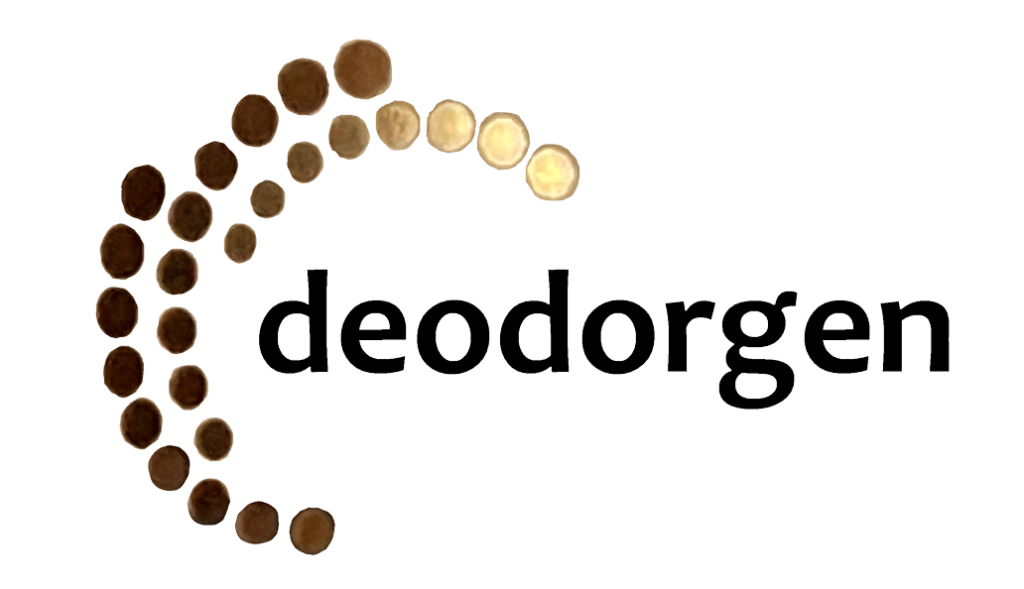The Truth about
trans-2-Nonenal

Chemical Formula of trans-2-Nonenal
Widely distributed in nature; found in beer, coffee, watermelon, palm oil, potatoes, carrots, bay leaves, cucumbers, etc.
And it is found on old people (over age 40)!
The toxicology sheets says, “No safety concern at current levels of intake when consumed as a flavoring agent.”
But it does repel cockroaches and even kills things at higher concentrations.
Year 1982
The Questions on Everybody's Minds:
"To Attract or Repel?"
This article from a 1982 issue of Science offers clues about cockroaches.
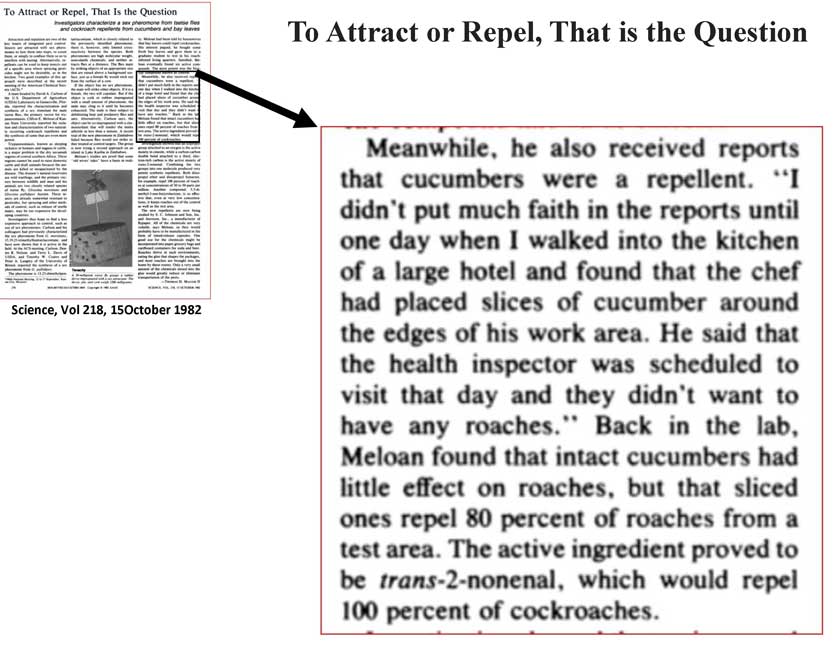
Don't Forget the Question - Read to the End

Question: Does trans-2-Nonenal repel cockroaches?
Answer: Yes. 100%, but not as effectively as stepping on them.
Question: Grandma is 85. She has that old person odor about her. Does she repel cockroaches?
Answer: YES! But especially when the lights are turned on.

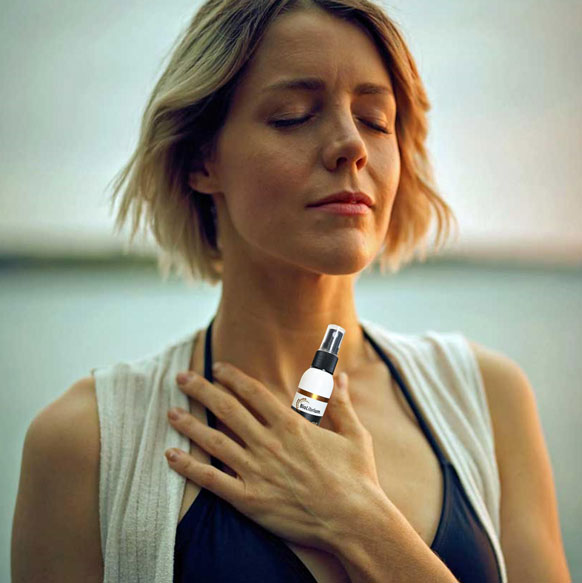
Question: I just turned 40. Should I be concerned??
Answer: Yes! But turning 40 is not your biggest problem. Your armpits are a big problem if you forget to use deodormeTM
Question: So what does trans-2-Nonenal kill?
Answer: It kills rabbits. It killed at least 5 rabbits! They put it on their skin. 3,700 millligrams per kilogram of rabbit killed half of them.

Dermal Rabbit LD50 means the single dosage in milligrams per kilogram (mg/kg) body weight which, when dermally (skin) applied for 24 hours, within 14 days kills half or more of a group of ten rabbits each weighing between 2.0 and 3.0 kilograms.
If killing rabbits doesn’t seem right to you, there are a lot of people who agree and they have looked at the problem in depth. A Guide for the Care and Use of Laboratory Animals, 8th edition, is available online. Check out the “3 Rs” of animal testing, Replacement, Refinement, and Reduction. You can read the entire volume HERE.
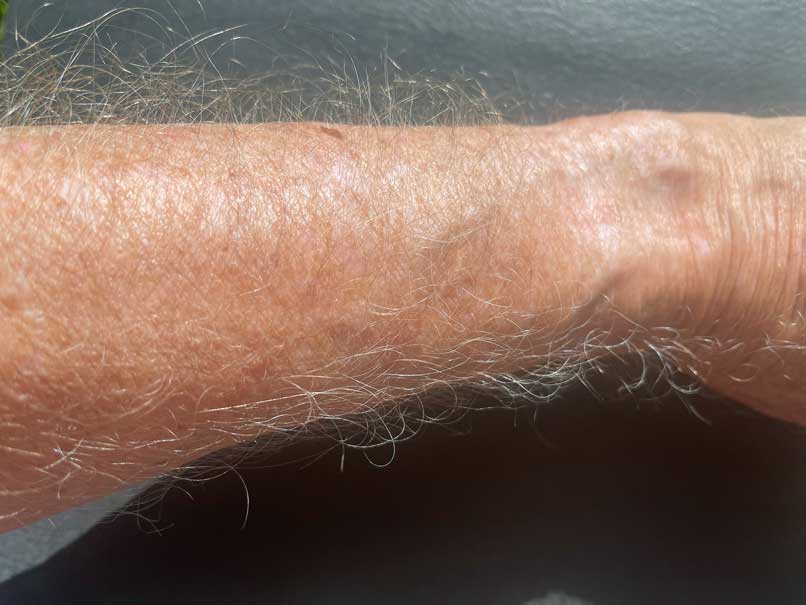
Question: How does trans-2-Nonenal get on old peoples’ skin?
Answer: We don’t know. Maybe they secrete it. Maybe oil goes rancid. Maybe both. Read on…
Year 2000
2-Nonenal Newly Found in Human Body Odor Tends to Increase with Aging
Journal of Investigative Dermatology, Volume 116, ISSUE 4, P520-524, April 01, 2001
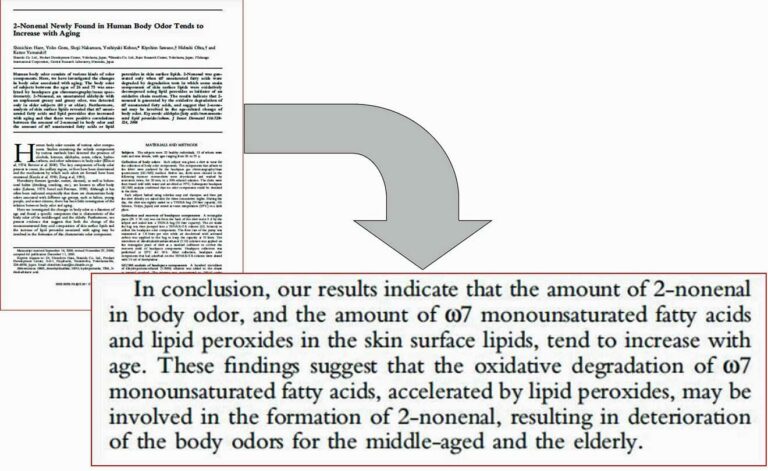
“These findings suggest that the oxidative degradation of ω7 monounsaturated fatty acids, accelerated by lipid peroxides, may be involved in the formation of 2-nonenal, resulting in deterioration of the body odors for the middle-aged and the elderly.” We underlined “may.” A Japanese Company did this study and people around the world have been trying to figure out how to cash in financially by trying to eliminate a problem that is not a problem.
Rancid Skin Oil
Normal Skin Oil
First of all, skin oil is a lot more than just oils. We should refer to them as lipids, which in chemistry includes many substances, such as triglycerides, waxes, fats, oils, and sterols. Technically sterols are alcohols but our biochemist friends insist on calling them lipids, which are also fats. Semantics!
They vary from one person to the next and individually from day-to-day. What’s normal for one person is different from another person’s “normal,” but for simplicity we will use the term normal to include all skin lipids of healthy individuals to differentiate from skin lipid pathology.
Normal skin lipids come from two sources. They are excreted directly from skin cells (epithelial cells) and also secreted as sebum from glands around hair cells.
Sebaceous Glands
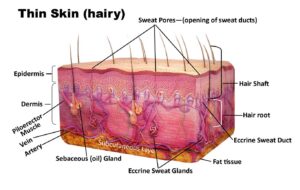 Humans have hair over most of the body even if it is very small and almost invisible. One type of gland around each hair is called a sebaceous gland. Cells from sebaceous glands produce their beneficial discharge by dying. When they die and excrete their contents, it’s known as sebum. Sebum is a combination of oils and simpler compounds produced by friendly* bacteria feeding on the discharge. When lipids from the glands mix with lipids secreted by skin cells, the skin becomes shiny, even greasy, on the surface. Besides lubricating the skin and keeping it soft, it forms a barrier against water loss, bacterial invasion, solar radiation, and frictional trauma.
Humans have hair over most of the body even if it is very small and almost invisible. One type of gland around each hair is called a sebaceous gland. Cells from sebaceous glands produce their beneficial discharge by dying. When they die and excrete their contents, it’s known as sebum. Sebum is a combination of oils and simpler compounds produced by friendly* bacteria feeding on the discharge. When lipids from the glands mix with lipids secreted by skin cells, the skin becomes shiny, even greasy, on the surface. Besides lubricating the skin and keeping it soft, it forms a barrier against water loss, bacterial invasion, solar radiation, and frictional trauma.
*Don’t be fooled if we accidentally call some bacteria friendly. They are not our friends, even if we do share about 30% of the same genes. Some are aggressive and nasty; others not so much. Our immune systems do a pretty good job of figuring it out most of the time.
Composition of Sebum
The composition of sebum changes from infancy through childhood. It makes major changes around the time of sexual maturation. Its chemical composition varies among individuals, by age, gender, diet, and even environmental conditions such as season of the year.
Some of the components of sebum include:
One of the families of free fatty acids that are secreted in the sebum are the unsaturated fatty acids like the well known omega-3.
Free fatty acids have shown antibacterial activity in the laboratory, which suggests they may directly contribute to the antimicrobial activity of the skin surface.
Omega-3 and omega-6 fatty acids are important parts of the human diet because we can’t synthesize them; they must be obtained from the diet. The fatty acid implicated in producing trans-2-Noneanal is Omega-7. It’s one of hundreds of fatty acids that we need to stay alive. Omega-7 seems to be important in helping with sugar control in the blood. We can make all we need assuming we have the building blocks from a healthy diet.
Omega-7 (ω-7 or n-7)
Although not classified as essential fatty acids, ω-7s have been shown to have important functions in human metabolism including better insulin sensitivity. The two most common ω-7 fatty acids are palmitoleic acid and vaccenic acid. The body can make them. They are abundant on the skin. But there are questions about forms of omega-7 from the diet. Are they universally healthy? Do they interfere with the body’s ability to make them? Does reducing dietary ω-7 reduce the amount on the skin and reduce production of trans-2-Nonenal?
It’s highly doubtful. And why does trans-2-Nonenal increase after age 40? These are interesting questions. Maybe someday there will be good answers.
When palmitoleic and vaccenic acid acids were chemically reacted with oxygen in the laboratory, the chemicals that resulted were hexanal, heptanal, 2-octenal and 2-nonenal. All have detectable odors; the last, 2-nonenal has the characteristic greasy, grassy odor increasingly associated with old age.
Rancid Unsaturated Lipids
Because ω-3,6,7,9,10. etc are unsaturated, they react with oxygen easily. That makes them rancid. Omega-3 fish oil doesn’t smell bad until oxygen in the air hits it. Keeping fish on ice slows the reaction with oxygen but can’t stop it. In fact, most fish oil purchased as a nutritional supplement is already rancid, which raises the question if it is harmful or helpful. We don’t answer questions about nutrition, at least on purpose. We are interested in fish oil because it stinks.
Fatty acids seldom occur as free fatty acids; they occur mostly as triglycerides (a glycerol molecule with three fatty acids). Bacteria easily break the bonds to the glycerol, releasing free fatty acids. Highly reactive chemicals formed from oxygen can also break the bond and then react with the fatty acid.
These potentially harmful substances (free radicals) can also be formed naturally from an organism’s normal metabolism. They can be harmful to cell membranes in high concentrations but can also act beneficially to help cells die a natural death (apoptosis).
Lipid Peroxidation
“Lipid peroxidation” is a term to describe the sequence of reactions when oxygen or free radicals react with unsaturated fatty acids. A lot of work has been done studying lipid peroxidation of ω-3 because fish oil is a valuable commodity and most of it is already spoiled before it gets to the consumer! If it stinks, it is oxidized.
Omega-7 (ω-7)
Omega-7 has been identified as contributing to the production of 2-Nonenal on skin, the stinky part of old people smell. When lipid peroxidation happens to triglycerides containing ω-7, or any unsaturated fatty acid, a lot of different compounds are produced, not just 2-Nonenal. This may explain why some old people smell worse than others. Some of the other compounds are also perceived as bad odors. Everybody’s metabolism is different and even varies from day-to-day in individuals.
Before getting too upset about potentially smelling like an old person, realize that life is not simple. Body cells go through cycles of proliferation and death. Oxidative stress is part of this cycle. In response to oxidative stress on cell membranes, the cells may produce antioxidants to survive or they may be close to dying anyway and give up. They do this in response to molecules that signal what reaction is appropriate. If they are overwhelmed, like the rabbit is when painted with CONCENTRATED trans-2-Nonenal, they just die. There is a big difference between parts per billion on the skin and reagent grade, 95% chemically pure 2-Nonenal. The flavor threshold for 2-Nonenal in the beer brewing industry is reported to be 0.1 parts per billion. Beer is said to be stale when the taste of 2-Nonenal gets too noticeable.
Stale beer is not attractive. But how about just a very small, imperceptible amount of 2-Nonenal? It’s there in your favorite beer.
It may be exhaled by your favorite under 40 ovulating female friend too. You may not know it because it doesn’t meet a threshold for conscious perception. And that brings us to the second part of the question.
Year 2010
This paper was published in the American Journal of Biochemistry and Biotechnology in 2010.
You can read it all HERE
The authors are from India and Mexico. Sometimes their English deviates from what we expect in technical writing but we cannot argue with their research. Well, actually we can argue with everybody’s research. Nevertheless they use good verbs like “suggest,” “appears,” and “may.”

How can you tell when ovulation occurs?
Buy a Mass Spectrophotometer.
Gas Chromatographs and Mass Spectrophotometers
Gas Chromatographs (GC) and Mass Spectrophotometers (MS) are very expensive laboratory instruments used to analyze and identify complex chemicals. In this study they identified volatile chemicals in women’s saliva that peaked in intensity when they ovulated.

The authors of the study seem a bit excited that they may have discovered an easy way to pinpoint ovulation. The only problem is that the substances they identified are volatile so unless you have a GC or MS to catch it every day and watch the trans-2-Nonenal peak, you should consider other options.
If timing ovulation is something that is important to you, the University of Utah has good advice on their website: HERE
Trans-2-Nonenal and Dodecanol (Dodeca=12, nol means alcohol)
You already know what trans-2-Nonenal is. In this study they found an alcohol that also peaked at the time of ovulation.
Dodecanol is a naturally occurring alcohol commonly called laural alcohol. It has 12 carbon atoms and an oxygen and hydrogen atom on its end. So it is 1-Dodecanol.
![]()
It’s tasteless but has a delicate floral odor when diluted and is unpleasant at high concentrations.
The bad news for rats is the LC50 (rat) is 1,050 mg/per cubic meter/for six hours. They made the rats breathe air with a concentration (LC=lethal concentration) of 1,050 milligrams of laural alcohol per cubic meter of air for six hours and half of them died!
So here is another chemical that smells good in tiny concentrations and but is toxic at high concentrations.
Are trans-2-Nonenal and Dodecanol Sex Pheromones in Humans?
Why would an ovulating human female secrete nonenal and dodecanol in her saliva at the moment of ovulation?
Evolution has worked its magic to make boys and girls like each other a lot at special times. Ovulation may be one of those special times.
Pheromones are the reason insects of a species like each other.
Honey bees have 15 known glands that produce a huge array of chemicals that govern behaviors of the entire hive (community). The list of honey bee pheromones continues to grow but among currently known pheromones are short chain volatile alcohols like 1-octanol and 2-nonenol (smells like cucumbers). These volatile alcohols tell bees when to swarm and attack an enemy. Smoke masks the alcohol vapors so the bees are not alarmed.
Humans have evolved in ways that make simple chemical attraction unnecessary, although it is believed they subtly exist. The cerebral cortex of a girl’s brain may tell her to flee from a man with a caveman beard, but a subtle volatile alcohol (dodecanol) on her breath may compel him to pursue her relentlessly.
These are important questions that keep the money flowing into research laboratories.
What is the Bottom Line?
The Bottom Line
The bottom line is an idiomatic expression, probably adopted from the accounting profession, suggesting that the profit or loss shown on the bottom line of a financial balance sheet can be relied upon as the final answer.
As everyone doing time in jail for income tax evasion can attest, the bottom line depends very much on the integrity of the person preparing the report. Science is full of wishful thinking. Unfortunately a lot of closely held personal opinions end up on the bottom line.
So here is another good idiomatic expression that answers the question if trans-2-Nonenal is a human pheromone: “The Jury is Still Out.”
The Jury is still out.
About the second question if trans-2-Nonenal is responsible for old person odor, it’s a hung jury.
The jury unanimously agrees that underarm odor is the worst in people after puberty. Second is bad breath. In assisted living facilities and nursing homes, it’s the odor of stale urine. Who would have guessed that?

We are neither judge, jury, nor prosecutor so we asked our resident expert about old person odor. Her opinion is obvious:
Maya does not like stale beer, coffee, watermelon, carrots, or bay leaves. She likes cooked potatoes with a lot of butter, MCT oil (derived from palm oil) as part of her ketogenic diet and intermittent fasting, and she likes old people over 40. She cautiously licks a person’s exposed bare arm as if to say, “You smell much better than a cucumber.”
We suspect the trans-2-Nonenal is below her critical threshold. More like a flavoring agent. Pleasant.
She’s cautious around babies. Almost like they don’t smell right.
Practical Advice
Odor is objectionable only when it reaches a threshold that can be detected by the person who finds it objectionable. Different people have vastly different sensitivities to detecting odors. People also become accustomed to odors and don’t notice them. This has been referred to as “nose blind.” It is common to enter a dwelling and be aware of unusual odors but soon that awareness wanes.
Environmental odors in a house can come from many sources: paint fumes, food, musty smell of molds in laundry rooms and teenagers’ dirty bedrooms to name a few. Air spray is commonly used to mask the odors. Finding and eliminating the source is a more sensibility strategy because air sprays may have mild toxic effects when inhaled.
Use deodorme for #1 body odor source.
Underarm odor is easily controlled by using deodormeTM but what about old people smell, which is really not perceived as objectionable until it meets that magic threshold?
Some deodormeTM users regularly go for several days to over a week without taking a shower. They never have an objectional odor. How do they do this?
Personal Hygiene without a Shower.
The #2 human odor problem is bad breath. Our study subjects have good oral health so their mouth odor is controlled by good oral hygiene. Most use an electric toothbrush. None uses mouthwash.
Whole Body Secretions
Trans-2-Nonenal and the hundreds of substances created all over the body from excretions, oxidation, and bacterial activity, some of which are volatile, absorb into clothing. It is very interesting that smelling the armpit of a deodormeTM user’s shirt is not objectionable just smelling the armpit. The rest of the clothing starts to stink, often quickly. It depends when the threshold is met. That threshold for detection is reached at different concentrations for different observers.
In places where there are barriers to easily washing laundry, people often wear a shirt or other piece of clothing for one day or part of a day, and then hang it to air out for a week. Hanging it in the sun hastens the evaporation of odor.
Our culture is brainwashed by commercial interests selling sweet smelling fragrances, soaps, perfumes, air fresheners, fabric softener, antiperspirants, mouthwashes, foot odor spray, to name a few. Some mask odor with a stronger fragrance; others kill bacteria indiscriminately.
A Better Way
Use deodormeTM to control armpit odor. Learn to care for the bacterial colonies that inhabit every inch of our bodies, inside and out. Avoid toxic substances on the skin and in the food we eat.
It is very difficult to avoid body odor if you are eating a lot of sugar and industrial oils. Metabolic problems and body odor go hand-in-hand.
Try to live long enough that old people smell comes not from trans-2-Nonenal but from not changing your diaper.
